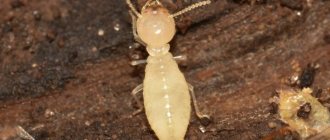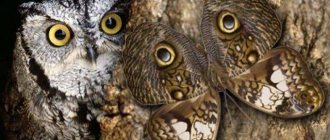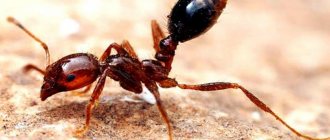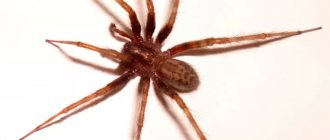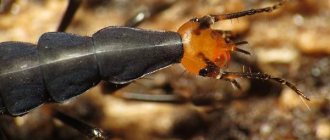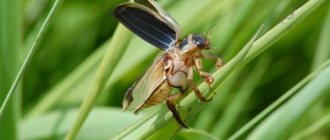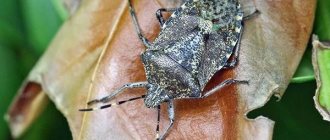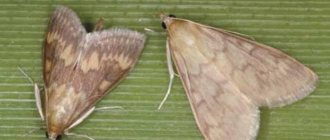Features of butterflies
Food for caterpillars is plants. But some species can be called predators and parasites. The main food of adult butterflies is nectar, juice of plant or animal origin. In some species of butterflies, the proboscis is not developed at all; they do not feed, so they live for several hours or days.
The annual development cycle of a butterfly varies depending on the species. Most often, butterflies produce one generation per year. There are species that produce two or three generations per year.
The most characteristic feature of representatives of the order of butterflies, or lepidoptera, is two pairs of wings covered with tiny scales, which remain on the fingers in the form of pollen if the butterfly is not carefully picked up. The color of butterfly wings depends on the color and arrangement of these scales, which form a whimsical pattern.
In addition, some species of butterflies have colorless scales that refract light rays, giving their wings a metallic shine. The bright upper side of the wings serves to attract a partner or may match the color of the flowers visited, and sometimes it scares off enemies or warns that the butterfly is poisonous. And the coloring of the lower surface of the wings (underside) in combination with their shape is designed to make the butterfly sitting down to rest invisible to enemies.
The wingspan of moths is only 3-8 mm, and some tropical butterflies and peacock eyes would not fit on the spread of this book if depicted at life size. The mouthparts of most butterflies are transformed into a soft, spirally twisted proboscis, adapted for sucking out liquid food.
Butterfly structure
Caterpillar structure
Butterflies are insects with complete metamorphosis. Worm-like larvae (caterpillars) emerge from the eggs laid by the female. The caterpillar has a segmented, elongated body with three pairs of thoracic legs. Several pairs of outgrowths on the abdomen are called false legs. Unlike adults, caterpillars have a gnawing type of mouthparts.
Basically, insects prefer to eat pollen, flower nectar, tree sap, overripe fruits, but there are also special species that are picky eaters. For example, the hawk moth, a honey lover, enters the hive and enjoys its favorite food. Some members of the nymphalid family replenish moisture loss by eating the urine and sweat of wild and domestic animals. Some tropical butterflies prefer crocodile tears as moisture.
Insects, which do not have a mouthpart at all and live extremely short lives, use supplies that were made when the caterpillar found it. Some types of butterflies are real vampires. They replenish lost strength by consuming animal blood.
Butterfly breeding
The shape and color of the wings are of great importance when breeding butterflies. Some species are sexually dimorphic: males and females differ in appearance, which makes it easier for lepidopterans to find a partner. Other species use pheromones to attract mates. Depending on the species, either males or females can attract a partner in this way. The mating dance is also characteristic of butterflies.
Mating occurs on plant leaves or the ground. It can last from 20 minutes to several hours. By fertilizing a female, the male not only transfers his seed, but also components that are useful during pregnancy. Some species have an interesting feature: after fertilization, a chitinous appendage appears on the female’s abdomen, which eliminates the possibility of repeated mating.
The mating process of the heliconid charitonia is interesting. The female begins to emit pheromones several hours before emerging from the pupa. Males flock to her and begin to fight with each other. The winning male fertilizes the pouch as it emerges from the pupa.
After fertilization, the female lays eggs. This is how butterflies are born. In the tropics, some species can produce up to three generations in one year.
The structure of butterflies
The body of the butterfly is clearly divided into three sections: the head, the thoracic region and the abdomen. The head is more or less spherical with a pair of large hemispherical eyes. Under the binocular you can see that their surface is formed by many individual facets, each of which corresponds to a separate eye. The complex gnawing mouthparts of caterpillars in butterflies are transformed into a sucking tube - a proboscis , curled into a spiral at rest, and a pair of three-segmented lower labial palps.
Butterflies can only obtain nutrients in liquid form. For most of them, this food is flower nectar. In a number of families of moths (some primitive moths, slender moths, cocoon moths, corydalis, moths) the proboscis is underdeveloped, and the butterflies do not feed at all (they live relatively short lives due to nutrients accumulated in the caterpillar stage). The antennae of butterflies have a varied structure.
Figure 1. Antennae of butterflies: 1 - thread-like; 2–3 - club-shaped; 4 - fusiform; 5 - comb; 6 - two-comb; 7 - feathery
Male moths are often more developed than females. Daytime butterflies are club-shaped, that is, they expand towards the top. The thoracic region of the butterfly bears three pairs of jointed legs. Butterflies, like all insects, are six-legged, although in the families of nymphalids and marigolds the front pair of legs is greatly reduced and does not function when walking. These butterflies are actually four-legged. In rare cases, there are no legs at all (for example, many female bagworms). Butterflies move quite successfully with the help of their legs, but the main organ of movement is, of course, the wings located on the sides of the thoracic region.
The wings of butterflies are large in comparison with the body, membranous, with a skeleton in the form of fan-shaped diverging veins; covered with chitinous scales, which often hide the venation. The shape of the wings is very diverse. However, in most species it more or less approaches a triangle, and when describing a butterfly, they distinguish three sides, or three edges (Fig. 2): the anterior one - from the base, or root, of the wing to its apex; external - between the tip of the wing and its rear corner; posterior - from the base to the rear corner. The size of the butterfly is estimated by the length of the front wing - the distance from the root of the wing to its apex. Below, each species sketch shows exactly this value, measured in millimeters. The surface of the wing is divided into at least 4 regions: basal , discal , postdiscal and marginal . The central—discal and postdiscal—areas are often called the central field.
Figure 2. The structure of an adult butterfly (imago) and the wing areas used in describing the figure: 1 - head; 2 - thoracic region; 3 - abdominal region; 4 - antennae; 5 - proboscis; 6 - eye; 7 - legs; 8 - discal spot. I - root region; II - discal region; III - postdiscal region; IV - submarginal region; V - leading edge; VI - outer edge; VII - posterior edge; VIII - wing apex; IX - back angle; X - wing root.
The venation of the wings of butterflies of different families plays an important role in elucidating family relationships. Without going into its details, we note the presence in the system of veins of the so-called central cell (see Fig. 2), limited on the outside by a short transverse (relative to the rest) vein. This cell is important in describing the wing pattern of many butterflies.
Scales cover the wings and body of the butterfly like tiles. They are varied in shape and contain coloring pigments that impart color and determine the pattern. Elongated scales along the outer edge of the wing form a fringe . In some species, the scaly cover of the wings can be very sparse and the wings turn out to be more or less transparent: this is typical, for example, for glass bees and bumblebee hawk moths, which are similar in appearance to wasps and bumblebees, respectively.
The coloring and pattern of the wings of butterflies reach exceptional diversity. In many cases, the nature of the pattern is species-specific, unique to a species or group of species, and is of critical importance for identification (recognition) of the species, especially in the field. However, one should keep in mind the individual variability of the pattern, which is more or less characteristic of each species. The well-known thesis that no two people in the world are exactly alike is fully applicable to butterflies.
In the color of the wing, one can distinguish the background color that occupies the largest area, on which the pattern is placed. The names of the individual elements of the design (spots, dots, strokes, holes, marginal border) are for the most part clear without much explanation. We consider it appropriate to note only a few special terms: discal spot - a spot located on the transverse vein, that is, on the outer edge of the central cell (Fig. 2), among representatives of the noctuid family called “ reniform ”; bandage - a wide transverse stripe or a series of spots adjacent to each other; peephole - a round spot bordered by a rim of a different color.
In moths, which almost never show the color and pattern of the underside (underside) of the wings, only the pattern of the upper side of the wings has evolutionary and diagnostic significance, and in the vast majority of cases - only the front wings, since the hind wings are usually completely hidden under the front wings. To identify species of diurnal butterflies, the pattern of both the upper and lower surfaces of the wings is important. Species from the most “difficult” groups of diurnal butterflies are most often diagnosed by the details of the pattern of the underside of the hind wings.
The abdomen of butterflies is usually cigar-shaped, longer than the chest, covered with scales and divided into segments (in males the number of abdominal segments visible from the outside is one more than in females). Inside are the organs of digestion and reproduction. The abdomen at the apex is specialized in connection with sexual function. In the male, the end of the abdomen bears a complex copulatory apparatus, consisting of several rigid appendages. The structure of the copulatory apparatus in almost every species has its own characteristic features. In some cases, species that are very similar in appearance are identified precisely by their copulatory organs, which must be prepared (dissected) in a special way for this purpose.
Fledgling butterflies are by no means carefree creatures, fluttering from flower to flower or frivolously flying into the light at night. They are faced with the global task of procreation, which is realized in different species in different ways. The male's goal is to find a female and fertilize her. The female’s goal is to wait for fertilization and then for the maturation of the eggs, which she must lay correctly. To solve these problems, butterflies are usually given 1–3 weeks - this is the life expectancy of most individuals. But there are no rules without exceptions, and the well-known peacock's eye, polyflower, and other true nymphalinae live several times longer. These butterflies appear in mid-summer, and become sexually mature only after overwintering, in the spring of next year. The other extreme is represented by the males of the bagworm family, whose lifespan is measured not even in days, but in a matter of hours.
The males of many butterflies, at least day ones, are born several days earlier than the females. First of all, they need to compensate for the deficiency of mineral salts, especially sodium, necessary for the development of sperm. Males obtain these substances, which are insufficient in the vegetarian diet of caterpillars, by sucking and filtering moisture on the soil, along roads, near streams, often forming accumulations in areas rich in salts.
After some time, the males of most species of diurnal butterflies begin to cruise low above the grass, looking for females that have recently emerged from their pupae, using mainly their vision. Males of other species of diurnal butterflies, which have strong, rapid flight, are characterized by so-called territorial behavior. They take a position, usually on tall grasses, bushes or trees, from which a wide view opens, and systematically attack all butterflies of their color flying past, drive them out of their area, and then return to the “observation post”. And so on until the expected female flies out of the grass or from a tree. These include many thickheads, moths, ribbonworts, nymphalids (including wrens, blackwings, multifloras and others), field pearlwort and some others, checkerworts of euphidrias, many-eyeds and marshmallows from the blueberry family. What helps the swallowtail and the podalirium find their other half is the innate desire of individuals of both sexes to fly uphill, higher and higher, until they reach a more or less pronounced peak.
Butterflies, like many insects, have a remarkably developed “chemical sense.” They themselves produce various chemical signals and perceive such signals very well. The males of many diurnal butterflies have groups of specialized scales, usually found on the forewings. These scales are called androconial and secrete a species-specific male pheromone that stimulates females. Before copulation, the male flutters for a long time a few centimeters above the female or sits near her and finely vibrates his wings. Options for the mating ritual may vary in detail, but all are aimed at obtaining chemical evidence for the female that this is a male of her species. Often the female refuses the male, showing this with her abdomen raised vertically upward.
The females of most nocturnal moths and the glass beetles that fly during the day, before their fertilization, also secrete pheromones of a special, species-specific composition. Odor receptors are located on the antennae of males, which are usually more feathery than those of females. The larger the surface of the antennae, the more receptors and the greater the likelihood of detecting the source of the signal. Males of many species perceive the female’s odors at long distances (up to 0.5–1 km, sometimes more), reacting to minimal concentrations—a few pheromone molecules per 1 m3 of air.
Chemical sense organs are located in some species on the legs. The females of many diurnal butterflies, before laying an egg, crawl on the plant, tasting it with their feet, or more precisely, they detect the presence in the plants of certain alkaloids important for the nutrition of the caterpillars. For example, a female cabbage plant feels mustard alkaloids when sitting on a leaf (which is typical for cruciferous plants - cabbage and others). There is a taste of mustard, which means it is a suitable plant and you can lay eggs. She can even lay eggs on a piece of paper smeared with mustard oil! A hungry butterfly senses (with its feet!) sugar in very small concentrations and reacts by unfolding its proboscis. The admiral butterfly unfolded its proboscis when it felt sugar dissolved in water in a concentration corresponding to 1 teaspoon of sugar per 50 tons of water!
Daytime butterflies become active at sunrise, although they usually begin to fly a little later, when the sun's heat reduces air humidity, and before that they can only crawl on plants. Before rising on the wing, diurnal butterflies usually take sunbaths, placing their open wings perpendicular to the sun's rays, or raise their body temperature by finely fluttering their wings.
The optimal time for activity of moths is twilight. After sunset, it is easy to see how cutworms, moths, and leaf rollers begin to ply in the air, many of which rush to flowering trees and shrubs (for example, bird cherry, viburnum, lilac). Butterflies usually fly to light sources at the end of twilight, instinctively, guided by a program according to which they should sit in shelters during daylight, and when it gets dark, fly from their dark shelters to places that are more open and illuminated. Therefore, moths fly at night to lanterns, the light of which is visible from afar. Having flown around the lamp, the butterflies usually sit chaotically on more or less illuminated surfaces. By morning twilight, most of them scatter to their shelters. In addition to light, many moths, from those groups that feed in the imago phase, are well attracted by baits moistened with honey (sugar) solutions.
Most butterfly species in the Southern Urals develop in a single generation throughout the year. Only about 20–25% of our species have two or three generations per year. These are, in particular, swallowtails, cabbageweeds and other true white moths, meadow jaundice, moths, many true bluebirds, some cutworms and corydalis, clover moths, four-moths and some others. Undoubtedly, there are such species among moths and moths, in particular those that live in rooms where they are capable of producing up to 4 generations per year. A number of butterfly species take two years to complete the full cycle from egg to adult. For example, the caterpillars of wood borers, many bagworms and nigella live for almost two years. It is not uncommon for pupae of hawk moths and corydalis to overwinter twice.
Overwintering of each individual species takes place at a certain stage, adapted to prolonged hypothermia. Before wintering, glycerol accumulates in the insect's body, which then acts as an antifreeze. More than half of our butterfly species overwinter in the caterpillar phase. Moreover, in some species, very young caterpillars overwinter, sometimes even without leaving the egg shell, while in others, on the contrary, they are adults, almost ready to become a pupa. Almost 30% of species overwinter as pupa. These are all our hawkmoths, downybacks, sicklewings, saturnias, many corydalis, more than half of the moths, about a quarter of the noctuid species, and individual representatives of other families.
No more than 5% of our butterflies overwinter in the adult phase. These are mainly representatives of the families of pied moths, flat moths and noctuid moths. Several species of leafrollers and moths overwinter as adults, as well as lemongrass and the well-known nymphalids - urticaria, anglewort, polyflower, peacock's eye and mourning. These butterflies are the first to delight our eyes in the spring, flying out of their winter shelters in the April thaw, and sometimes earlier. Following them, usually during May and early June, species appear that overwintered as pupa or adult caterpillars. During the warm season, some butterfly species are replaced by others according to the same schedule.
Common fenestrated moth Thyris fenestrella (Scopoli, 1763)
Remarkable metalweed Autographa excelsa (Kretschmar, 1862)
Hebe the bear Arctia festiva (Hufnagel, 1766)
Erebia cyclopia (Eversmann, 1844)
← Previous article
Distribution of butterflies
→ Next article
Preface
Order of butterflies, or Lepidoptera
Lepidoptera are the largest group of insects from the phylum arthropods. A characteristic feature of all representatives of the order of butterflies is the scaly multi-colored cover of the body and wings. These scales are nothing more than modified hairs. They have different colors and can create complex and bizarre patterns.
Another identifying feature of the order of butterflies is the sucking mouthparts in the form of a long tubular proboscis. To eat, the butterfly extends its long proboscis, plunges it deep into the flower and sucks up the nectar.
The main source of food for the order of butterflies is the nectar of flowers, so they are considered the main pollinators of flowering plants. There is an opinion that with the advent of flowers on Earth, butterflies appeared.
Today there are about 150,000 species of squamates that live on all continents except Antarctica. Tropical areas are especially rich in brightly colored butterflies. In addition to butterflies, there are several other similar orders of insects: Homoptera, Diptera, fleas. We invite you to get acquainted with the main representatives of each squad:
- Homoptera. There are more than 30,000 species. These include cicadas, whiteflies, psyllids, scale insects, aphids, gall midges, and scale insects. All of them belong to sucking insects that feed on plant sap. They have a piercing-sucking mouth like a proboscis. Why are they called Homoptera? Nature has endowed them with two pairs of transparent wings - front and rear.
- Diptera. This order includes a million species. They arose more than 100 million years ago. Everyone is familiar with mosquito bites and annoying flies. They have a front pair of wings. Their hind wings can be called small appendages - halteres, which maintain balance during flight.
- Fleas. There are more than 1000 species. These are small insects without wings and with flattened sides. The size of fleas is from 1 to 5 mm. They have a large abdomen and legs, but a small chest and head. They have a slippery and smooth body dotted with bristles and hairs. All this is to make it easier to move through the fur of animals where fleas live. An adult flea is a bloodsucker that parasitizes birds and mammals.
Lepidoptera are of great importance in nature and human life. After all, butterflies are excellent pollinators of plants. Many large butterflies, such as swallowtail and Apollo, simply fascinate with their beauty. They become exhibits of many entomological collections.
Nutritional Features
Basically, insects prefer to eat pollen, flower nectar, tree sap, overripe fruits, but there are also special species that are picky eaters. For example, the hawk moth, a honey lover, enters the hive and enjoys its favorite food. Some members of the nymphalid family replenish moisture loss by eating the urine and sweat of wild and domestic animals. Some tropical butterflies prefer crocodile tears as moisture.
Insects, which do not have a mouthpart at all and live extremely short lives, use supplies that were made when the caterpillar found it. Some types of butterflies are real vampires. They replenish lost strength by consuming animal blood.
Distribution and lifestyle
Monarchs migrate east for the winter.
Insects and butterflies flutter almost all over the planet. The habitat excludes only the glaciers of Antarctica. They flutter in the highlands and in flowering valleys.
Many animals have a nocturnal lifestyle, but many live and function during the day. In winter, some butterflies hide in cracks in the bark of trees. But there are species that survive cold in the egg or larval stage.
Nutrition
Dietary preferences may vary depending on the type of animal. This:
- flowering nectar;
- honey;
- water;
- animal blood.
Some butterflies do not have a proboscis, so they feed only on what they have accumulated. The caterpillar stores, pupates and turns into a beautiful moth. But the lifespan of this species is not long, several days.
Butterflies.Lifestyle of butterflies in winter
These creatures spend the winter in different ways. Some varieties live only three summer months, being born in June. Cold weather leads to their death. Others manage to wait out the winter while remaining in the egg state. Most of the species existing today survive cold weather in the pupal phase. Certain individuals encounter frosts as adult insects. They crawl into deep cracks and tree hollows. Examples include burdock, urticaria and lemongrass. But there is an exception to the rule. In this case, the lepidoptera leave their home without waiting for the warm days to pass. They fly to other countries. The monarch and oleander hawk moth are the most famous travelers.
How many species of butterflies are there on our planet?
To describe all the types of butterflies and their names, our article will probably not be enough - there are about two hundred thousand species on Earth. Lepidoptera lived alongside other animals since the Jurassic period - this is confirmed by archaeological finds. Nowadays, beautiful representatives of this order can be found on any continent except Antarctica.
Butterflies are insects characterized by large, patterned wings covered with tiny scales. They are conventionally divided into daytime and nighttime.
Daytime birds, when sitting down, fold their wings vertically over their backs, and their antennae (antennae) are thin, club-shaped (with a thickening at the top). Most butterflies feed on flower nectar, sucking it out with a long soft proboscis.
Features of the classification of butterfly species
The order Lepidoptera includes more than 158 thousand different families and subspecies. Lepidopterists - entomologists who study this type of winged insects, use various complex classification systems, in which the criteria that define this or that species of butterfly into a separate group are constantly being replaced.
The best classification is considered to be one in which all the various families and species are divided into 4 suborders:
- primary toothed moles;
- proboscis butterflies;
- heterobatmy;
- proboscis butterflies.
This classification system is used by professional lepidopterists and amateur collectors of various types of butterflies. Such insects are also divided according to their lifestyle into diurnal and nocturnal.
The largest nocturnal butterfly is Attacusaltas, with a wingspan of 300 mm. It is often confused in the sky with a bird due to its large size.
Toothed moths
These are the smallest lepidoptera, their size ranges from 4 to 15 mm. They have a gnawing type mouthparts, and their distinctive feature is their large antennae, the size of which reaches 75% of the size of their wings.
This subgroup includes up to 160 species. One of the most famous is the family of micropteryxcalthella.
Proboscis butterflies
Until 1967, this subgroup did not exist in the systematization of lepidopteran species. All representatives without proboscis were classified as toothed moths.
On the small wings of butterflies, the span of which is no more than 25 mm, there are tiny scales covered with cream or black spots. Then they were allocated to a special subgroup.
It includes moths of various species: AsopiafarinalisL, Dioryctricaabieteila.
Heterobathmya
This is the smallest subgroup, containing only one family, Heterobathmiidae. It includes no more than 10 species.
The most famous are:
- Heterobathmiadiffusa;
- Heterobathmiapseuderiocrania;
- Heterobathmiavalvifer.
Proboscis families
These are butterflies of a large number of families, differing in different sizes and colors. In total, this subgroup includes over 150 thousand species of Lepidoptera. Representatives of the Sailfish family are considered the most famous and beautiful. They have multi-colored colors.
These butterflies have wingspans ranging from 50 to 250 mm. On the surface of the wing scales there are characteristic patterns of spots of black, blue and red. The most famous representatives of this family are:
- Swallowtail, listed in the Red Book;
- "Glory to Bhutan";
- Queen Alexandra's Birdwing.
Another well-known family included in this subgroup is the Nymphalinae. Features include wide wings that do not have thickened or rough veins. They reach a span of 50-130 mm. The pattern on the wings is distinguished by a variety of patterns and variegated colors.
The most striking representatives of the Nymphalina family are Lepidoptera:
- Admiral;
- Daytime peacock eye;
- Mourning maid;
- Urticaria, etc.
Very beautiful individuals of the family Lepidoptera of the proboscis type, lead a diurnal lifestyle. They feed on the leaves of various plants and flower nectar.
Other well-known representatives of proboscideans are lepidoptera from the families of Belyanok, Golubyanka, and Pestryanka.
How do butterflies protect themselves from predators?
Butterflies are very fragile and defenseless creatures, so nature made sure that they could protect themselves from predators in a variety of ways. Many butterflies have a very unpleasant taste, a foul smell, and some are simply poisonous: this is due to the fact that when they were caterpillars they ate poisonous plants.
After a predator tries to bite on a poisonous butterfly, he will stay away from this species for a very long time, and perhaps always. Those butterflies that, for various reasons, do not have such powerful means of defense, use another “weapon” - coloring that copies the coloring of inedible butterflies.
Moreover, some butterflies, trying to avoid being caught by a predator, imitate not only the colors, but even the shape of their wings. “Disguising” as bumblebees, wasps, as well as dry leaves, pieces of bark, twigs and twigs is also very popular. By the way, various “eyes” - a popular pattern on the wings of butterflies - are also a way to protect yourself from the enemy.
Requirements for growing a butterfly from a caterpillar at home
- Several caterpillars, the brighter and thicker the caterpillars, the more beautiful your butterflies will grow.
- The caterpillar's food is the grass or leaves on which you found the caterpillar.
- A butterfly incubator is an ordinary salofan bag or a three-liter jar.
- The waiting time is usually several weeks and not more than a month.
Interesting:
- I found several identical caterpillars on a bush and collected a dozen. I picked up a full package of these leaves and twigs. So, when you find the caterpillars, you should do the same. If you find a caterpillar on the asphalt and want to turn it into a butterfly, then search the Internet for this caterpillar and find out what plant it eats.
- At home, I made two incubators. I put twigs with leaves in the bag, filling 40% of the bag space. I made holes in the bag with a regular nail to allow air for my pets. Everything is easy here, just repeat. Do not skimp on the number of holes, and place the holes in the middle and top parts of the bag.
- I placed 5 of my caterpillars in one house, 5 in another. And he didn’t throw them in one pile, but spread them out evenly, although I think they might crawl back to their places on their own. Then he tied the bag on top and put it in a place where it was neither dark nor light. No matter what, the sun doesn’t fall on them, but no matter what, they don’t have eternal night. Place it on a corner of a shelf, or a table, or a bedside table, decide for yourself depending on your utility capabilities.
- I constantly looked and observed, the first days they only crawled along the branches and ate leaves. The spectacle was not exciting, boring and not interesting. But we have to wait!
- After about a week there was a lull, when I looked closely I saw that there were no caterpillars! There are cocoons, how they wrapped themselves in them, I don’t even know if I missed this moment. Further, it’s even more boring to watch them, they hang stupidly and that’s it. But we wait further.
- I don’t remember how many days passed there, but I saw the chrysalises and again missed the moment when the cocoon becomes a chrysalis. There was a suspicion that this was happening at night, but in fact, I just rarely looked there. I was interested in the end result.
- One fine morning, around 11 o'clock, I woke up from a strange noise. There was something rustling in the bag. I took a closer look and saw that a yellow butterfly was fluttering there. Surprisingly, it happened. Like a savage, I put my hand in the bag and began to catch it, naturally I scratched the enamel on its wings with my fingers, gently grabbed it by the abdomen and on the balcony released it into the street and it flew away. I returned to my bags and saw a small head bursting out of the pupa into the light of day. She worked hard and for a long time to get out. Sometimes I wanted to reach out and help, but I stopped myself with the thought that I could only do harm. So don’t stop nature from doing its thing, don’t pretend to be surgeons!
- And when the butterfly crawled out before my eyes, I put my hand up and it, having just been born, was not afraid of me at all. I could pick her up and carry her, put her down and pick her up again, she only climbed, but didn’t fly. There was a thought that she was disabled and wouldn’t fly, but still, she flew up and continued to contact me without fear, allowing herself to be picked up (naturally not by the wings). This is just a miracle! I now know that she didn’t fly because her wings needed to dry.
Unfortunately, the remaining 8 caterpillars died. Nothing hatched from their pupae. Perhaps they did not have enough food supplies, perhaps the conditions were not the same or there were few holes, but most likely it was a bit dry, since they need 80-60% humidity. But in any case, out of 10 caterpillars I have, 2 butterflies were born without much care.
Are all butterflies pests?
There are butterflies that really harm the garden. They are called: white moth, cabbage moth, moth, leaf roller, codling moth, cutworm. These butterflies lay eggs from which caterpillars hatch, and the caterpillars eat leaves of cabbage, lettuce, apples, potatoes, peas, pine needles and even clothing. In our country, 1000 species of butterflies have been registered that damage crops and other plants.
Of the garden pests, the most famous and widespread butterfly is the apple codling moth, whose caterpillars penetrate inside a young apple, feeding on its pulp and seeds.
The cabbage white butterfly, or cabbage moth in common parlance, is the largest of the cabbage-damaging butterflies.
White butterfly caterpillars develop on cruciferous plants and often damage garden crops. Particularly dangerous is the cabbage caterpillar, which is bluish-green in color with three yellow longitudinal stripes and black dots. It eats cabbage so much that often only large veins remain from the leaf. Over the summer, 2 generations of cabbage butterflies hatch from eggs.
However, there are very few pest butterflies - only 2%, which is 2 butterflies out of 100! And the rest are useful for our areas or do not affect them in any way.
Man fights butterfly pests in dangerous ways - using agrotechnical and biological methods, aggressive chemical and mechanical means. Many substances that people use pollute the soil, destroy plants, kill all living things, and harm nature.
Nature itself has the smartest, safest and most selective method of pest control. Why not follow the natural course of things and stop killing butterflies thoughtlessly and indiscriminately?
Life cycle
Lepidoptera are insects with a full cycle of transformation. The life cycle of a butterfly consists of 4 stages:
- egg;
- larva (caterpillar);
- chrysalis;
- adult insect (imago).
The duration of each cycle depends not only on the species of the insect, but also on climatic and weather conditions.
Egg
After mating, female butterflies lay eggs. Most lay eggs on the leaves or shoots of the food plant, but some lay eggs in the soil or on its surface.
Oviposition
The shape and shade of eggs can be very different. Oval, round, conical, cylindrical eggs are painted in white, sand, light green, pink, blue, brown. The embryo located in the egg is protected by a dense shell, and its development occurs due to nutrients.
The egg stage lasts from 7 – 15 days to several months (if the egg overwinters). Depending on the species, butterflies lay different numbers of eggs from several dozen to a thousand.
Caterpillar
At this stage, insects look like worms. They have a well-developed gnawing mouthpart, so immediately after hatching they begin to actively feed. Thanks to this, the development and growth of the butterfly larva occurs quite quickly. In addition, caterpillars store building substances necessary for subsequent transformation into a butterfly.
Caterpillars experience 4-5 molts, after each of which they increase in size. The larvae of some species molt up to 40 times. The development of a butterfly larva lasts from several weeks to several years.
What do caterpillars eat?
For the most part, the larvae eat plant food (leaves and young shoots, tree bark, inflorescences and fruits of plants), unlike adult lepidoptera, which feed on the nectar of flowers. But the diet of some caterpillars consists of foods such as:
- wood;
- lichens;
- mushrooms;
- skin, wool, hair, horny substances;
- wax;
- weakened and sick relatives;
- caterpillars of other species;
- scale insects;
- snails
During development, the caterpillar increases in size tens of times.
How long does the caterpillar stage last?
The duration of the caterpillar stage depends on the type of insect and the conditions in which it lives. From the moment the larva emerges from the egg until the start of pupation, it can take several days or several years.
Doll
Caterpillars have special glands that produce a strong, silky thread. When the larval phase is completed, the insect begins to secrete a thread and wrap itself in it, forming a cocoon. It is inside the cocoon that the amazing transformation of a caterpillar into a butterfly takes place.
The pupae are absolutely motionless and most often have a nondescript coloring, which saves them from attacks by birds and insect predators. The pupal stage lasts from 2-3 weeks to several months.
Imago
When the adult butterfly has finally formed, it secretes a caustic substance that corrodes the shell of the cocoon. Through the resulting hole, the insect climbs out. After this, the butterfly needs a few more hours for its wings to dry and become dense, after which the beauty takes off on its first flight in its life.
Birth of a butterfly
The lifespan of the imago varies from several hours to several months, but most often the butterfly lives for a couple of weeks.
The benefits of butterflies for nature
In the field of plant pollination, these life-affirming creatures of nature occupy second place in importance after bees, and sometimes even first. They give life to plants, but do not forget about the continuation of their kind. For example, the yucca moth living in the desert is the only pollinator of flowers of the cactus of the same name. The butterfly transfers pollen from flower to flower and immediately lays 3 eggs. Subsequently, part of the seeds developed from pollen “continues the genus” of the yucca cactus, and part goes to feed the caterpillars of the butterfly itself.
Some tropical plants (a number of species of the orchid, bindweed, etc. families) are also pollinated exclusively by butterflies. And some caterpillars feed on harmful insects. For example, the caterpillar predator of the wormeater butterfly feeds on olive moths, helping people fight garden pests.
Useful ones include the silkworm butterfly (oriental and oak), used in the national economy. But among them there are also harmful ones: fall armyworm, nun moth, gypsy moth, goldentail, codling moth, furniture moth, moth (poisonous and dangerous for birds), etc.
Studying the flights and migration of butterflies is of great importance for preventive measures to combat agricultural pests.
Classification of butterflies
In the order Lepidoptera, which includes butterflies, there are more than 150 thousand different species. Therefore, it is not possible to clearly divide into types. There are 4 main suborders.
- Primary toothed moths , the smallest representatives, all representatives with gnawing type mouthparts.
- Proboscis butterflies, representatives with dark or brown scales.
- Heterobathmyas, which represent a separate family of 10 different representatives.
- Proboscis , the largest and most diverse suborder, striking in its size and species.
Do butterflies have enemies?
Yes. Wasps, spiders and predatory flies.
Which butterfly is the rarest?
This is the Brazilian Morpho.
Is it possible to breed butterflies?
Yes, but the life of such a pet is not very long.
The meaning of butterflies in human life
In the silk industry, man uses the silkworm as a fiber producer. Some butterfly caterpillars feed only on weeds, so they are sometimes used as biological weapons against the latter. That is, caterpillars (for example, American cactus moth) are released into places where weeds have grown heavily and they eat harmful plants.
Butterflies can also cause harm. Some caterpillars cause untold damage to forest and agricultural crops. Caterpillars of winter, flax, wheat, and cabbage cutworms infect vegetable gardens or sugar beet fields. And cabbage was considered a real threat to vegetable growers and gardeners. Hawthorn harms cherries and pears.
What determines the lifespan of a butterfly in the wild?
The lifespan of any butterfly in nature depends, first of all, on the species and living conditions. For example, female butterflies belonging to the family of sacbiformes (or psyches) live for only a few days. Males often do not live even a day. This is due, first of all, to the fact that psyche butterflies cannot feed after crawling out of the pupa: their oral apparatus is completely reduced at the transformation stage. The only function available to them is reproduction, for which there is not much time left.
Bagworm butterflies live just over a day.
Butterflies of the hawkmoth and silkworm families live a little longer: regardless of gender, their lifespan is about three days. Against this rather sad background, the familiar and hated by all gardeners cabbage plants, which can live up to twenty days, stand out favorably. The absolute record holders for life expectancy are urticaria, monarch butterflies - the lifespan of both of them reaches nine months in nature - as well as lemongrass, which do not die for a whole year.
Lemongrass holds the record for longest life expectancy among butterflies.
How do they catch butterflies?
The first thing that comes to mind when the need arises to catch butterflies is, of course, a net. It is the main tool for catching these beautiful insects. At the same time, despite the apparent simplicity of its design, the net requires some skills when handling it. The body and wings of a carelessly caught butterfly can be severely damaged, which will give it a completely unmarketable appearance and make it useless for the collection.
The net is the most obvious tool for catching butterflies.
In turn, the net is also subject to a certain number of requirements from expert entomologists. First of all, before starting to catch butterflies, a knowledgeable user must decide on the length of the shaft. It depends directly on the place of capture and the average flight altitude of the target butterfly species above the ground. For example, hunting butterflies in the rainforest often requires the use of a net with a shaft three to four meters long. For such cases, many manufacturing companies create special nets with a telescopic, folding or plug shaft made of aluminum.
For convenience, many manufacturers make the nets collapsible
Features of the structure of the body and wings
Butterflies are insects that have two main organs: a body and wings.
The multi-jointed body is covered with a hard shell of chitin, its parts are:
- head;
- breast;
- abdomen.
The head of Lepidoptera is round and inactive with a flattened nape. Its lateral surface is occupied by large eyes, arranged according to the facet principle.
In addition to large eyes, some species of barrels also have small eyes behind the antennae. On the head there is a mouthparts, which, depending on the type of insect, can be gnawing or sucking.
The antennae are located in the border zone separating the parietal part from the forehead. Their structure and length depend on the size of the butterfly and what species it belongs to. With their help, she perceives smells, air movement and navigates the environment.
The chest of this winged insect consists of three segments:
- front;
- average;
- rear
There are 3 pairs of legs on the middle and back parts. The front pair has special spurs with which the insect cleans its antennae.
The abdomen is cylindrical in shape and consists of 10 ring-like segments. The spiracles are located on them.
These Lepidoptera have two wings. The size of insects is usually determined by the length of butterfly wings, which can reach from 3 to 310 mm.
The entire surface of the wing is covered with special scales, which can only be seen with a very strong lens. Entomologists usually classify these flying insects into different species based on size and color and the size of the butterflies' wings.
The variety of colors serves as protection for butterflies. In one case, it helps to mimic the environment using the color of the wing, in others it scares away birds and animals that feed on such insects. Bright colors seem to warn that this individual is poisonous.
